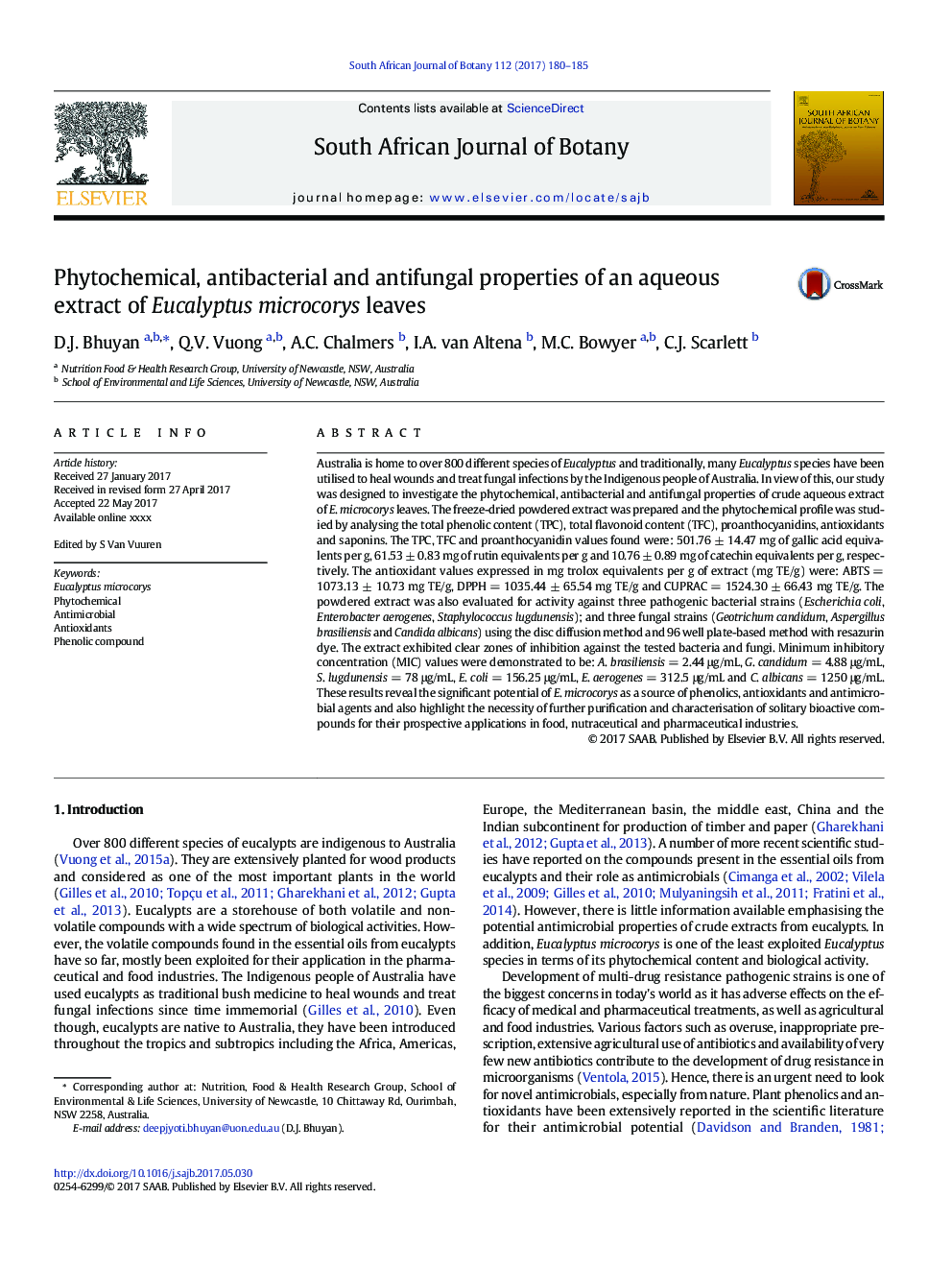| کد مقاله | کد نشریه | سال انتشار | مقاله انگلیسی | نسخه تمام متن |
|---|---|---|---|---|
| 5763173 | 1625146 | 2017 | 6 صفحه PDF | دانلود رایگان |
عنوان انگلیسی مقاله ISI
Phytochemical, antibacterial and antifungal properties of an aqueous extract of Eucalyptus microcorys leaves
ترجمه فارسی عنوان
خواص فیتوشیمیایی، ضد باکتری و ضد قارچی عصاره آبی برگ های میکروکوری اوکالیپتوس
دانلود مقاله + سفارش ترجمه
دانلود مقاله ISI انگلیسی
رایگان برای ایرانیان
کلمات کلیدی
میکروکنار اکالیپتوس، فیتوشیمیایی، ضد میکروبی آنتی اکسیدان ها، ترکیب فنل،
موضوعات مرتبط
علوم زیستی و بیوفناوری
علوم کشاورزی و بیولوژیک
علوم زراعت و اصلاح نباتات
چکیده انگلیسی
Australia is home to over 800 different species of Eucalyptus and traditionally, many Eucalyptus species have been utilised to heal wounds and treat fungal infections by the Indigenous people of Australia. In view of this, our study was designed to investigate the phytochemical, antibacterial and antifungal properties of crude aqueous extract of E. microcorys leaves. The freeze-dried powdered extract was prepared and the phytochemical profile was studied by analysing the total phenolic content (TPC), total flavonoid content (TFC), proanthocyanidins, antioxidants and saponins. The TPC, TFC and proanthocyanidin values found were: 501.76 ± 14.47 mg of gallic acid equivalents per g, 61.53 ± 0.83 mg of rutin equivalents per g and 10.76 ± 0.89 mg of catechin equivalents per g, respectively. The antioxidant values expressed in mg trolox equivalents per g of extract (mg TE/g) were: ABTS = 1073.13 ± 10.73 mg TE/g, DPPH = 1035.44 ± 65.54 mg TE/g and CUPRAC = 1524.30 ± 66.43 mg TE/g. The powdered extract was also evaluated for activity against three pathogenic bacterial strains (Escherichia coli, Enterobacter aerogenes, Staphylococcus lugdunensis); and three fungal strains (Geotrichum candidum, Aspergillus brasiliensis and Candida albicans) using the disc diffusion method and 96 well plate-based method with resazurin dye. The extract exhibited clear zones of inhibition against the tested bacteria and fungi. Minimum inhibitory concentration (MIC) values were demonstrated to be: A. brasiliensis = 2.44 μg/mL, G. candidum = 4.88 μg/mL, S. lugdunensis = 78 μg/mL, E. coli = 156.25 μg/mL, E. aerogenes = 312.5 μg/mL and C. albicans = 1250 μg/mL. These results reveal the significant potential of E. microcorys as a source of phenolics, antioxidants and antimicrobial agents and also highlight the necessity of further purification and characterisation of solitary bioactive compounds for their prospective applications in food, nutraceutical and pharmaceutical industries.
ناشر
Database: Elsevier - ScienceDirect (ساینس دایرکت)
Journal: South African Journal of Botany - Volume 112, September 2017, Pages 180-185
Journal: South African Journal of Botany - Volume 112, September 2017, Pages 180-185
نویسندگان
D.J. Bhuyan, Q.V. Vuong, A.C. Chalmers, I.A. van Altena, M.C. Bowyer, C.J. Scarlett,
